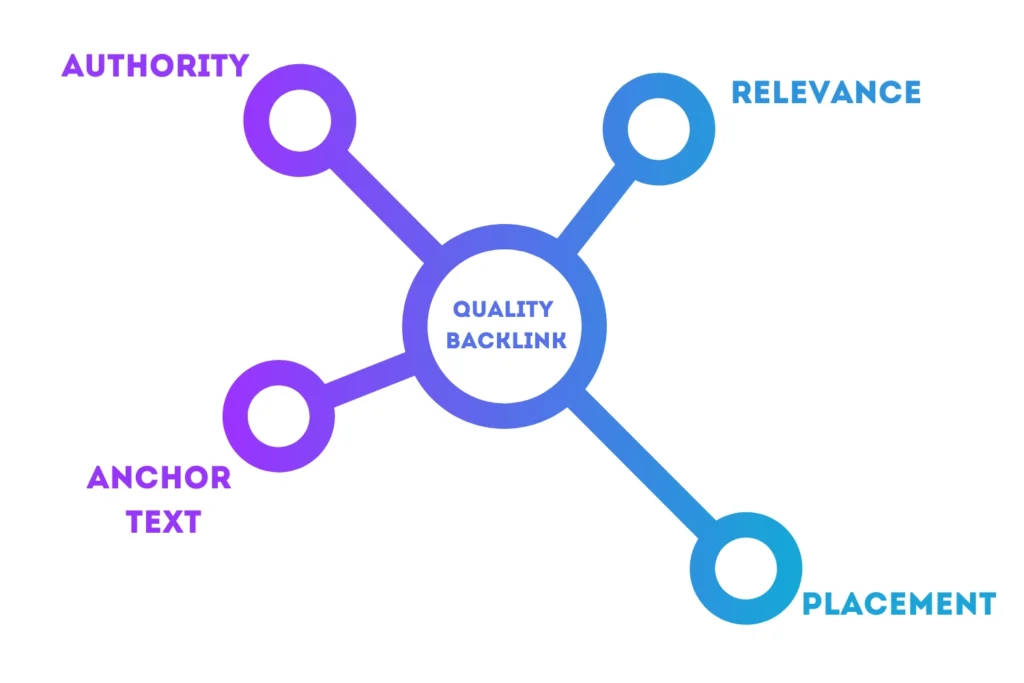
What is a Backlink?
The term “backlink” is used in the field of natural referencing (SEO) to refer to a hypertext link within content pointing to another site. It can be opposed to the internal link, which can take the same form but exclusively refers to content on the same site.
The internal link is mainly used to facilitate user navigation and page indexing by Google robots, while the backlink serves to:
- Indicate to the user the external location of information/product
- Transmit popularity from one website to another
It is this second function that SEO is particularly interested in. It is considered that inserting a backlink into content is a way of recommending other content, another web page. This recommendation is a measure of trust that Google uses in its relevance algorithm to determine the ranking of search engine results. To simplify, the more backlinks a website has, the more popular it becomes in Google’s eyes.
Signs of a Hight-Quality Backlink
The quality of a backlink depends on several criteria related to the site that establishes the link:

- The theme of the site. The theme addressed must be similar to that of the site to which the link points. Only accept links from sites whose semantics are close to yours.
- The reputation of the site. It is best to prioritize sites that are authoritative in their field, i.e. sites that are recognized as reliable, popular, and well-positioned. It is better to have few high-quality backlinks than a multitude of links from sites that are not well-positioned for Google and therefore have a little reputation.
- The diversity of links. Link acquisition must be natural for Google to recognize it as relevant. Links must be established at a regular and natural pace. The types of links must be varied (from the text as well as images). Sites must be different: blogs, directories, showcase sites, etc. Anchor texts must be diverse, i.e. sometimes optimized, sometimes neutral, exact, etc. Finally, make sure to avoid over-optimized anchor texts that do not appear natural.
- The location of the link. Links located at the top or bottom of the page are of little interest. For greater relevance, the link should be located within the text, with an anchor text written naturally.
Respecting these criteria to follow a consistent backlink policy is essential for a site’s SEO. The quality of backlinks is verified by Google, particularly since the implementation of the Google Penguin filter, which aims, among other things, to detect abusive net linking practices.
Why do You Need to Implement Backlinks?
Developing backlinks is essential for several reasons:
- Gain a reputation by getting SEO juice. The more popular and recognized the sites are, the better the quality of SEO juice and the more your reputation grows.
- Increase traffic by recovering part of the audience from the site that establishes the link.
- Be better positioned in search engine results pages (SERP). Google’s algorithm takes into account backlinks and their quality to calculate a site’s position in the SERP.
- Encourage search engine robots to explore. By establishing links throughout the web, you increase the opportunities for robots to crawl your site.
How to Get More Quality Backlinks to Your Website?
First and foremost, you need to ensure that your website offers an optimal user experience, as well as interesting content for visitors and Google.
It will be difficult to obtain quality backlinks if your site itself is not of quality.
Content Marketing for SEO
Content marketing is an effective way to get quality backlinks. The idea is simple: you create content that is relevant and interesting enough for other webmasters to spontaneously create links to it.
To generate natural links to your website, the ideal is to create a resource center with content that has a high potential for sharing.
Everyone loves quality content!
Design a Generator or Tool That is in Demand
This is a particularly effective way to get backlinks, as it allows you to generate inbound links while offering real added value to your visitors. This will benefit your traffic.
To succeed, think about what your audience might need or want and try to offer the most relevant solution possible.
Conduct a Study or Survey
This is one of the most popular techniques for getting backlinks, as it allows you to collect valuable data along the way.
Surveys and studies have a great potential for sharing on the internet, and therefore generating natural backlinks.
Keep Up With the Latest News
Newsjacking involves integrating a current event into your content to make it more relevant (and increase its chances of being shared).
This technique can be used for different types of content: blog posts, infographics, videos, etc.
The key is to be quick and offer an original point of view on the subject. However, this type of article has a fairly limited lifespan.
Content That Creates Buzz
Content that creates buzz is often original, humorous, shocking, or simply very well done. It has a high potential to be shared on social networks and generate natural traffic.
If getting backlinks on Facebook, for example, doesn’t give you juice, it still increases the article’s visibility.
To succeed, don’t hesitate to be creative and try to offer original content that stands out from the competition.
How to get backlinks for free?
To be honest, very often a free backlink is free in name only. After all, it doesn’t include the effort you put into getting it!
Ask Nicely (You Never Know)
There are probably still some web editors or bloggers willing to provide an SEO link to your page without receiving anything in return. But let’s be honest, if you are looking for quality links, it’s quite rare.
If you show up out of nowhere to boost your rankings without offering anything in return, it is quite certain that you will receive negative, even violent responses.
Improve an Existing Third-Party Article
Improving an existing article can allow you to obtain a backlink for free (or in exchange for content). You can directly propose to a blog editor, for example, to add (quality) content to their (excellent) article, to clarify a point, for example. Note that this type of backlink negotiation requires tact!
You can also look for a source that has already been cited by the website you are targeting, and deliberately publish an article on your website that is of better quality than that source.
Then, come back to the editor of the targeted website and propose that they link to your page instead. They will gain in quality, and you will gain in visibility.
This technique is also called “Skyscraper“!
Fix Broken Links
Note that this also works for broken links. Look on the website from which you hope to obtain a backlink to see if they link to sources that no longer exist. Publish an appropriate article on your webpage and propose to the third-party site editor that they replace their obsolete source with yours.
What works well with this technique is that you bring added value to the website editor by solving a broken link problem for them.
They save time, gain quality, and in return, you gain visibility. It’s a win-win situation!
Have Your Product or Service Tested
You can offer to have a product or service tested or evaluated in exchange for a free sample and, of course, a backlink to your website. This is called “product placement”.
This works particularly well with themed blogs. You can hope that the website editor will write an informative article with photos, which will help improve your reputation.
Be careful on your way to building an organic and relevant backlink list. Beware of overly promotional content, which is less valued by Google and potentially penalized. Cheap or free backlink packages generally hide some pretty shady SEO methods.
They may even do more harm than good. It is very difficult to disavow a link or have it removed.
If your link profile is too spammy, you may have to make significant efforts to clean it up before you can start working on your rankings again.
So, how do you get backlinks? It depends on whether you want quality links or if you prefer to have a risky link profile.
You can personally approach bloggers and ask them to evaluate your product or talk about it on their blog. You can submit your site to directories or participate in link exchanges.
And, of course, you can create quality content that people will want to share and link back to nature.
The best solution for obtaining backlinks depends on your business and the type of links you are looking for. But remember, quality always trumps quantity when it comes to links.
Focus on obtaining unique links from reputable sites with high domain authority, and you’ll be on the right track to improving your SEO ranking on search engines.



